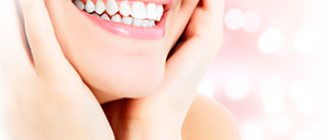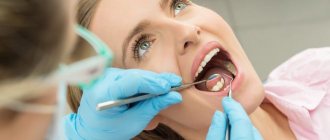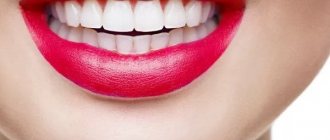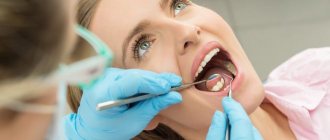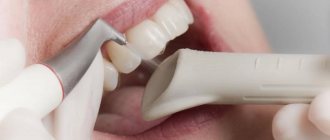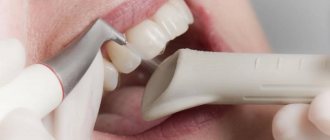Professional teeth cleaning includes a whole range of measures aimed at completely cleansing the surface of the teeth and oral cavity from all types of dental deposits. Due to the fact that many clients of the Apex dental clinic often ask the question of how teeth are cleaned, today we decided to talk in more detail about this, paying attention to the methods of professional cleaning.
Let's talk about the two most popular teeth cleaning options today: ultrasonic teeth cleaning using an ultrasonic device and the Air Flow method, which involves the use of a device that sprays a mixture of water, air and crystalline soda onto the teeth under high pressure. Well, first, let’s look at the process of professional teeth cleaning in general.
How does teeth cleaning work at a professional level?
First of all, to carry out professional teeth cleaning, you need to make an appointment with a dentist-therapist at a dental clinic, since it is this doctor who carries out the procedure.
It is mandatory to preliminarily assess the condition of the teeth and oral cavity, and identify indications and contraindications for the manipulation. After consultation with a specialist and an objective examination, the dentist cleans the enamel from plaque and stones. At this stage, various tools and equipment can be used, including ultrasonic teeth cleaning, Air Flow system, etc.
After removing all types of dental plaque, the surface of the teeth is polished to remove some stains, as well as to smooth their surface as much as possible to prevent the formation of plaque in the future. The final stage of professional cleaning is the application of fluoride varnish to strengthen the teeth.
Can Air Flow be used by pregnant women?
Pregnancy may well be a reason to refuse the procedure. This is due to the fact that a pregnant woman has an impaired calcium metabolism in the body, which is why the tooth enamel becomes too sensitive, and Air Flow can injure it. So you should not clean your teeth using this method during pregnancy.
Indications for professional teeth cleaning
There are many indications for professional teeth cleaning, ranging from the banal presence of dental deposits, including tartar, and ending with preparation for dental implantation or other serious dental interventions.
The extremely beneficial effects of teeth cleaning in a dental office determine the popularity and demand for such a service. Remember that regular visits to a dentist for medical examinations and professional cleaning are the key to the health and longevity of your smile!
Advantages and disadvantages of procedures
Ultrasonic cleaning has the following advantages.
- The procedure is safe because it is non-contact and is carried out without the use of aggressive chemicals.
- It copes well with various types of deposits that cannot be removed by a toothbrush.
- The scaler copes with deposits under the gums.
- Teeth acquire a natural shade.
Interesting! The disadvantages include the impossibility of performing the procedure for people with braces and other structures (prostheses, etc.); cleaning cannot be performed in the first trimester of pregnancy.
Advantages of the Air Flow procedure.
- No pain or discomfort.
- The enamel is protected from injury.
- It is possible to get rid of dental plaque in inaccessible places.
- It is acceptable to perform cleaning on patients with braces, implants and other structures.
Important! At the same time, Air Flow cannot remove hard plaque or deposits under the gums. The procedure does not cope with microbes that cause inflammation in the mouth.
Features of ultrasonic cleaning and teeth cleaning with the Air Flow device
If we talk about ultrasonic teeth cleaning, this procedure includes several directions of action. First of all, the method allows you to effectively clean your teeth of plaque, including that formed as a result of smoking and eating food coloring. Ultrasound effectively fights subgingival and supragingival dental plaque, including hard tartar.
Using ultrasonic teeth cleaning, it becomes possible to rinse periodontal pockets, the lack of timely treatment of which often leads to inflammatory diseases of the gums and periodontium. In addition, ultrasonic teeth cleaning, however, as when using the Air Flow device, involves polishing the teeth using professional pastes.
As a result of ultrasonic teeth cleaning, a slight whitening effect is observed (on average by 1–2 shades). The advantages of the method are its versatility and high quality, painlessness and safety, as well as the bactericidal properties of ultrasound.
As for brushing teeth with Air Flow, this procedure uses a high-pressure jet of a mixture of water, compressed air and sodium bicarbonate (soda). The result is the cleansing of dental surfaces from all types of dental plaque and the elimination of surface pigmentation. Air Flow teeth cleaning is also effective in interdental spaces.
Pros and cons of Air Flow abrasive cleaning
Advantages of the method
- safe, painless procedure;
- removes yellow and brown stains from wine, coffee, cigarettes, eliminates age spots;
- prevents further accumulation of plaque and the formation of hard tartar;
- Suitable for cleaning the surfaces of implants, crowns, orthopedic products in the mouth.
Minuses
- not suitable for removing tartar;
- does not clean subgingival deposits;
- does not have a bactericidal effect on enamel and gums (although it removes bacterial plaque).
Contraindications include diseases of the respiratory system, periodontitis, the presence of multiple carious lesions in the oral cavity, and pregnancy.
Recommendations after professional teeth cleaning
To ensure that the results of professional teeth cleaning with ultrasound or the Air-Flow method are as long-lasting as possible, experts recommend adhering to the following rules whenever possible:
- After the procedure, replace your toothbrush, and make it a rule to change it strictly every 3 months.
- It is also recommended, within two days after professional teeth cleaning, to eliminate, if possible, the influence of external factors that contribute to the deterioration of the condition and color of teeth. These include smoking, drinking coffee and tea, other coloring products (berries, ketchup and tomatoes, chocolate and red wine), etc.
- Experts also draw attention to the importance of thoroughly brushing your teeth according to all the rules (twice a day, if necessary, using dental floss and mouthwash, etc.)
- It is recommended to use toothbrushes with soft bristles, due to the fact that even products with a medium degree of hardness often cause “micro-scratches” on the enamel, where plaque subsequently accumulates and easy penetration of pigments occurs, changing the color of the teeth.
- To maintain the health and beauty of your teeth, it is recommended to have your teeth professionally cleaned twice a year.
What should you do after cleaning?
After ultrasonic or Air Flow cleaning, dentists recommend abstaining from certain foods and smoking for several hours. Otherwise, you can damage the enamel or paint it undesirable colors.
You should avoid the following products:
- too hard food;
- food with a high content of dyes (the origin of the dye does not matter);
- sour food;
- tea, coffee, chocolate, wine.
Important! If you ignore these recommendations, pigment plaque will soon form on your teeth. In addition, the enamel becomes more sensitive.
It is worth noting that in the first few days after cleaning, the patient may notice excessive tooth sensitivity, slight pain and bleeding gums. If you follow the dentist's advice, the discomfort will quickly go away.
Procedure
Air Flow teeth cleaning in St. Petersburg is performed as follows:
- A saliva ejector is placed under the tongue to keep the mouth dry.
- A cap is placed on the patient’s head, glasses are placed on the eyes to protect them from the powder suspension (it will settle).
- The dental vacuum cleaner turns on. It will begin to suck up debris from hard plaque that appears during the cleaning procedure.
The doctor cleans the surface of the teeth with the tip of the device.
Indications and contraindications
The following factors are indications for Air Flow:
- the appearance of solid deposits;
- discoloration of tooth enamel;
- dental defects that are difficult or impossible to eliminate using other dental methods;
- chemical bleaching;
- dental implantation or prosthetics.
Other methods will have to be used if the patient:
- there is an acute oral disease;
- diseases that impair nasal breathing;
- severe diabetes mellitus;
- epilepsy was detected;
- there are infectious diseases;
- severe asthma;
- severe manifestations of allergies.
At the first contact, the dentist is obliged to inform the patient of the entire list of contraindications. If he has encountered any of the diseases/conditions listed, alternative methods must be used.
After the procedure, you are prohibited from eating for two hours. Increased tooth sensitivity is allowed. Because, in addition to plaque, a thin layer is removed from the enamel.
Mixture composition
Glycine is the main component of the mixture. It is he who provides the softest impact. It can be replaced with soda. The mixture may contain additives with fragrances, which makes cleaning much more pleasant.
Anesthetic mixtures are offered to clients who have gum problems or have extremely sensitive teeth. The powder contains lidocaine, so it is also not suitable for people with allergies.
Air Flow cleaning: how it works
As we have already said: the device creates a mixture of compressed air, water and particles of a fine abrasive substance (sodium bicarbonate). This mixture is applied to the teeth under high pressure. Particles of sodium bicarbonate hit the plaque, as if knocking it off the enamel, and the water-air spray washes away the abrasive particles and fragments of the removed plaque.
When using this method, damage to tooth enamel is completely eliminated due to the size and special shape of sodium bicarbonate granules. In addition, for patients with damaged or particularly sensitive enamel, it is possible to use the “Air-Flow Soft” powder version, which contains an abrasive with a smaller particle size.
However, the manufacturer guarantees that when using Air-Flow Classic powder, which has a standard abrasive particle size, you will not get scratches on the surface of your teeth. This is achieved by giving the abrasive particles a rounded shape, carried out using special equipment.
Contraindications
Removing plaque and deposits using the Air Flow device is considered a minimally invasive procedure that is well tolerated by the human body and does not harm its health. And only in rare cases is the procedure impossible. The following conditions and pathologies are such contraindications.
- The patient has not reached 15 years of age.
- Following a salt-free diet.
- Chronic respiratory diseases.
- Increased sensitivity of tooth enamel.
- Individual allergic reactions to the manipulations performed or the composition of the abrasive powder for cleaning.
- Pregnancy period.
Important to remember! Professional cleaning of the oral cavity with Air Flow is carried out only after prior consultation with a dentist. In case of chronic diseases, consultation with your doctor is necessary.
Cost of the procedure
The average cost of the procedure is 5,000 rubles. The price of the service is determined based on the complexity of the problem with which the patient came to the dentist, the total volume of dental work and the price segment of the clinic. Quite often there are hot discounts on the Air Flow procedure.
Author: Elena Kopylova Dentist-therapist, endodontist. Work experience more than 8 years.
The information is for reference only. Before treatment, consultation with a doctor is necessary.
Ultrasound removes bacterial plaque in hard-to-reach places
This method allows you to completely get rid of subgingival deposits. Ultrasonic waves are an analogue of sandblasting mixture. After exposure to ultrasound, water removes the remaining foreign particles from the oral cavity.
Ultrasonic waves:
- Cleans the interdental space and dentition from bacterial deposits.
- Remove tartar and serum stones.
- Gives the enamel a white tint.
- Destroy pathogenic microorganisms.
The use of ultrasound is necessary for the prevention of infectious and caries diseases in the oral cavity. Non-contact technology allows you to completely remove plaque on tooth enamel in hard-to-reach places, without erasing or damaging the protective coating of hard tissues.
The ultrasound method is not used if the patient has implants or prostheses installed, because orthopedic structures may be damaged during the procedures. Doctors do not prescribe this cleaning, like Air flow technology, to pregnant women. The list of contraindications for ultrasound exposure includes: cardiovascular and respiratory diseases.
conclusions
To choose between ultrasound and Air Flow, a person must indicate the purpose of cleaning. If you need to get rid of plaque caused by coffee or smoking, it would be better to choose Air Flow. However, only ultrasound can deal with hard plaque. Ultrasound should also be chosen if the patient needs to prevent caries or gingivitis.
Of course, in order to understand which cleaning should be chosen in a particular case, a consultation with a dentist is necessary. He will suggest the most effective cleaning method suitable for a particular case.
We can say that Air Flow is an excellent method of prevention; it should also be used before artistic restoration. Air Flow can be performed even if you have ceramic dentures.
Important! Any chosen method effectively removes and protects teeth from plaque and various deposits, and also helps prevent caries. The final choice will be made by the dentist.

